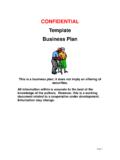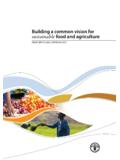Transcription of Overview of Vision and the Visioning Process
1 - 1 - March 2005 Overview of Vision and the Visioning Process A Story from the Middle Ages Three stone masons in the Middle Ages were hard at work when a visitor came along and asked them what they were doing. The first stone mason was hard at work, sweat beading his brow. I am cutting this stone, he grumbled. The second stone mason, though less distraught, responded with a deep sigh, I m building a parapet. The third stone mason replied with a radiant face, I am building a beautiful cathedral that will glorify God for centuries to come. -- Author unknown A challenging yet achievable Vision embodies the tension between what an organization wants and what it can have (Peter Senge, The Fifth Discipline, 1990). Definition of Vision A Vision of Success is a clear and succinct description of what the organization or community should look like after it successfully implements its strategies and achieves its full potential.
2 It is an expression by the people about what they want the organization to be a preferred future, a word or picture of an organization you choose to create. A Vision statement for an organization should include the organization s: mission basic philosophy, core values or cultural features Goals (if established) basic strategies performance criteria important decision making rules ethical standards of all employees A Vision statement for a community often includes a description of what the community will look like in the - 1 - March 2005 future (related to housing, agriculture, trails etc), and how it will embody opportunities and challenges. Benefits of a Creating a Vision Organizational members can see how they fit in an organization Conception precedes perception Agreement on Vision gives the organization more power The more specific and reasonable the Vision , the greater the realization Can help members recognize barriers to realizing the Vision May reduce organizational conflict Helps the organization stay attuned to its environment Establishing a Vision In most cases, a Vision for success is not necessary to improve organizational effectiveness Most organizations may want to wait until they go through one or more cycles of strategic planning before developing a detailed Vision .
3 New organizations, and communities, however, often establish a Vision of what/where they want to be at the beginning of the Process to establish consensus on purpose and values to guide issue and strategy identification. A Vision should include desired outcomes and benefits A Vision should grow out of past decisions and actions as much as possible A Vision should be inspirational A Vision should be widely disseminated and used to help guide organizational decisions and actions A Vision can be created at any point in a strategic planning activity. How to establish a Vision - Process There are several ways to establish a Vision . All of these processes should begin with a brief educational Overview of what a Vision is, what it does, and what the benefits are. In some cases its useful to provide sample Vision statements, although we recommend allowing the group to develop a Vision statement without being influenced by sample statements.
4 This allows maximum creativity. Your University of Wisconsin-Extension educator can help you design a Visioning Process that meets your needs. - 1 - March 2005 Example Visioning processes: 1. Develop a worksheet with a list of key questions to elicit values, desired future state, challenges, and unique features of the organization from your participants (see resources below for guidance on key questions). Work in small groups (especially when working with a large group of people). After each group has answered the questions and shared them with the larger group, have them craft a Vision statement that embodies these answers. Small groups would then work as a big group to combine the parts of each Vision statement that they like best. After crafting one draft Vision statement, test it against the list above which outlines the key components of a Vision statement.
5 2. For smaller groups, have each person write their own version of a Vision statement on a sheet of paper silently for 2-5 minutes. Each person then passes their paper on to their neighbor. The neighbor underlines the key words and phrases they like best. Pass the statements on to the next person, and have them underline the key words and phrases they like best. Repeat until everyone has seen (and underlined) everyone else s Vision statement. Use a nominal group or other technique to get the common phrases and words up on a flipchart, and begin crafting a single Vision statement. 3. Have each person write the headline of a newspaper story about the organization 20 years in the future that tells about the success the organization has had. Share stories, and develop a list of common Vision themes.
6 Use this as a basis for writing a Vision statement. Many variations of this Process are possible. 4. Describe the future state in words, or with pictures. This is often used as a community- Visioning tool, but a variation of it may work for organizations. Completing your Vision Statement A Vision statement can be drafted in a group, but its probably best to leave the final wordsmithing to a single person, or small volunteer group, so as not to bog down the Process . Of course, the final version needs to be reviewed and approved by everyone (usually at the next meeting). Sources: - 1 - March 2005 Bryson, J. Strategic Planning for Public and Nonprofit Organizations A Guide to strengthening and sustaining organizational achievement. 1995. Jossey-Bass Publishers. Bryson, J.
7 And Alston. Creating and Implementing your Strategic Plan a Workbook for public and non-profit organizations. 1996. Jossey-Bass Publishers. Green, G. et al. Building our future - A Guide to Community Visioning . University of Wisconsin-Extension publications No. G3708. Available at University of Wisconsin-Extension, Strategic Thinking In-Service materials, 1998.





